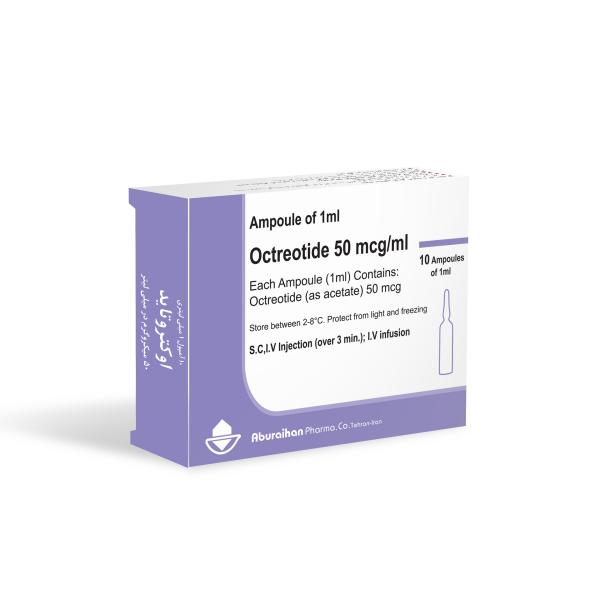Octreotide
Octreotide
0.05mg/ml ampoule
Acromegaly, Carcinoid syndrome, Gastroenteropancreatic neuroendocrine tumors, functional, vasoactive intestinal peptidesecreting (VIPomas)
Mechanism of Action:
Octreotide mimics natural somatostatin by inhibiting serotonin release and the secretion of gastrin, VIP, insulin, glucagon, secretin, motilin, and pancreatic polypeptide. Decreases growth hormone (GH) and IGF-1 in acromegaly. Octreotide provides more potent inhibition of GH, glucagon, and insulin as compared to endogenous somatostatin. Also suppresses LH response to GnRH, secretion of thyroidstimulating hormone and decreases splanchnic blood flow.
Method of Administration:
Acromegaly:
SubQ: Initial: 50 mcg 3 times daily; titrate to achieve target GH and IGF-1 levels. Usual effective dose: 100 mcg 3 times daily; range: 300 to 1,500 mcg/day. Doses above 300 mcg/day rarely result in additional benefit; if increased dose fails to provide additional benefit, the dose should be reduced.
Carcinoid syndrome:
SubQ, IV: Initial: 100 to 600 mcg/day in 2 to 4 divided doses. If additional symptom control is needed, may increase by doubling the dose every 3 to 4 days until symptoms are controlled; usual range: 50 to 750 mcg/day. Experience with doses above 750 mcg/day is limited; however, may consider a continuous SubQ infusion of 1,000 to 2,000 mcg/day off label in patients who remain symptomatic on intermittent doses.
Gastroenteropancreatic neuroendocrine tumors, functional, vasoactive intestinal peptidesecreting (VIPomas):
SubQ, IV: Initial: 200 to 300 mcg/day in 2 to 4 divided doses. If additional symptom control is needed, may increase by doubling the dose every 3 to 4 days until symptoms are controlled; usual range: 150 to 450 mcg/day. Doses >450 mcg/day are rarely required; however, may consider a continuous SubQ infusion of 1,000 to 2,000 mcg/day off label in patients who remain symptomatic on intermittent doses
Notes
Contraindications:
Hypersensitivity to octreotide or any component of the formulation
Interactions:
Antacids: May decrease the serum concentration of Octreotide. Risk C: Monitor therapy
Antidiabetic Agents: May enhance the hypoglycemic effect of Hypoglycemia-Associated Agents. Risk C: Monitor therapy
Antidiabetic Agents: Hyperglycemia-Associated Agents may diminish the therapeutic effect of Antidiabetic Agents. Risk C: Monitor therapy
Fingolimod: Bradycardia-Causing Agents may enhance the bradycardic effect of Fingolimod. Management: Consult with the prescriber of any bradycardia-causing agent to see if the agent could be switched to an agent that does not cause bradycardia prior to initiating fingolimod. If combined, perform continuous ECG monitoring after the first fingolimod dose. Risk D: Consider therapy modification
Histamine H2 Receptor Antagonists: May decrease the serum concentration of Octreotide. Risk C: Monitor therapy
Inhibitors of the Proton Pump (PPIs and PCABs): May decrease the serum concentration of Octreotide. Risk C: Monitor therapy
Selective Serotonin Reuptake Inhibitors: May enhance the hypoglycemic effect of Agents with Blood Glucose Lowering Effects. Risk C: Monitor therapy
Pregnancy and Lactation:
Data concerning use in pregnancy are limited. In case reports of acromegalic women who received normal doses of octreotide during pregnancy, no congenital malformations were reported
Octreotide is present in breast milk. The decision to breastfeed during therapy should consider the risk of infant exposure, the benefits of breastfeeding to the infant, and benefits of treatment to the mother.
Warning and Precaution:
- Cardiovascular disease: Use with caution in patients with heart failure or concomitant medications that alter heart rate or rhythm; bradycardia, conduction abnormalities, and arrhythmia have been observed in acromegalic and carcinoid syndrome patients. Cardiovascular medication requirements may change.
- Excessive GI fluid loss: In patients with conditions associated with excessive GI fluid loss receiving TPN, concomitant use of octreotide may reverse fluid losses and cause increases in serum zinc; monitor zinc levels.
- Hepatic impairment: Use caution in patients with hepatic impairment; dosage adjustment may be required in patients with established cirrhosis.
- Renal impairment: Use with caution in patients with renal impairment; dosage adjustment may be required in patients receiving dialysis.
Adverse Reactions:
Hypertension, peripheral edema, sinus bradycardia, Alopecia, hyperhidrosis, pruritus, skin rash, Hyperglycemia, hypothyroidism, Abdominal distress, abdominal pain, biliary obstruction, cholelithiasis, constipation, diarrhea, flatulence, gallbladder sludge, nausea, upper abdominal pain, vomiting
Storage:
Refrigerate at 2°C to 8°C, protect from light.

